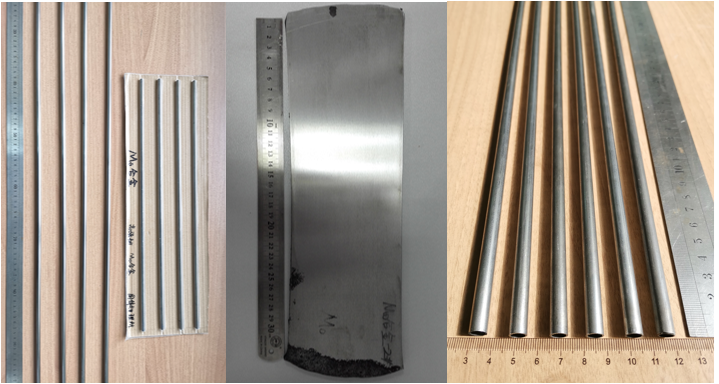
A kind of high-performance molybdenum alloy, nanoscale ZrC dispersion strengthened Mo alloy with high strength and excellent ductility, was fabricated recently by a collaborated research team from Institute of Solid State Physics, Hefei Institutes of physical science (HFIPS), Chinese Academy of Sciences (CAS), and Nuclear Power Institute of China.
The related research was published in Acta Materialia.
The performance of this nanostructured Mo-ZrC alloy, obtained through powder metallurgy and rotary swaging, was impressive, according to the team.
At room temperature, the yield strength of it is 920 MPa, 26% higher than TZM alloy, which is currently used in market. The total elongation (TE) is 34.4 %, more than doubled compared with TZM.
Researchers also tested its performance at 1000oC and 1200oC, respectively. The ultimate tensile strengths (562 MPa and 483 MPa) were much higher than that of previously reported alloys under the same condition, including ODS-Mo, La-TZM, La2O3-TZM, TZM and NS-Mo, while exhibiting good ductility.
"The recrystallization start temperature of the Mo-ZrC alloy is around 1400 oC," said LIU Rui, who conducted the research, “which indicates the remarkable thermal stability of this material.”
He further explained structure of the alloy. Synergistic effect of nanoscale ZrC particles dispersion strengthening, fine-grain strengthening, and grain boundary purification ensured its excellent mechanical properties and thermal stability.
Molybdenum (Mo) and its alloys have attracted much attention with its good performance. But pure Mo has many drawbacks like low ductility at room temperature (RT), inadequate strength at high temperatures etc.
In this research, through computational simulations, the research team found that the segregation of some interstitial impurities such as oxygen (O) at grain boundaries (GBs) is a predominant reason for GB embrittlement and low ductility in Mo alloys, while interstitial C atoms and ZrC particles can effectively improve the strength of GBs. Based on this, researchers adopt nanoscale ZrC particles with high melting temperature, high hardness and low neutron absorption cross-section as strengthening phase to refine grain size and improve the strength and thermal stability by pinning dislocations and GBs. Besides, ZrC as an O getter, can react with O at high temperatures and thus alleviate GB embrittlement.
"The prepared high-performance Mo-ZrC alloy has good application prospects in space reactor and high temperature industries," said LIU, "we expect to apply this strategy in other refractory alloys for high-temperature applications."
The work was supported by the National Key Research and Development Program of China, the National Natural Science Foundation of China, the Foundation of Science and Technology on Reactor Fuel and Materials Laboratory and the HFIPS Director's Fund, CAS.

Microstructure and room temperature engineering strain-stress curve of nanostructured Mo-ZrC alloy, and comparison of tensile properties of various Mo-based materials at room temperature and 1000°C. (Image by JING Ke)

Grain structure of Mo-ZrC alloy and pure Mo before and after high temperature annealing. (Image by JING Ke)

Mo-ZrC alloy rods, plates and tubes. (Image by JING Ke)